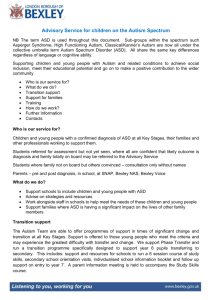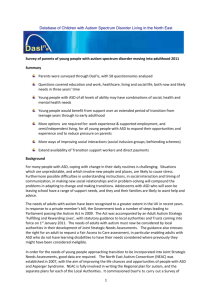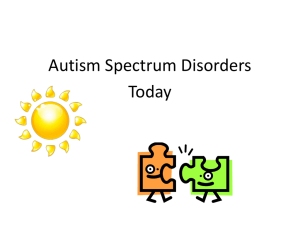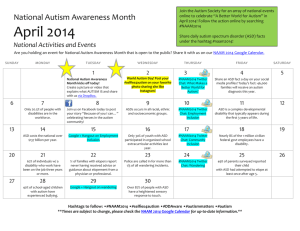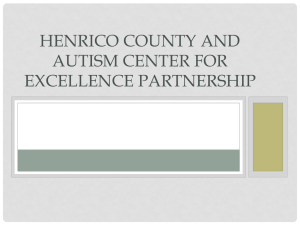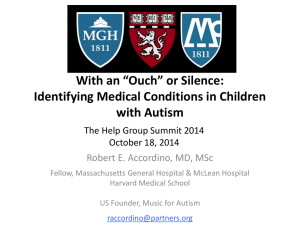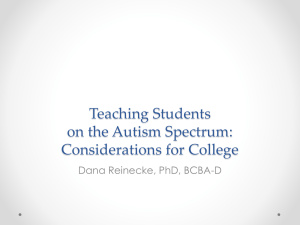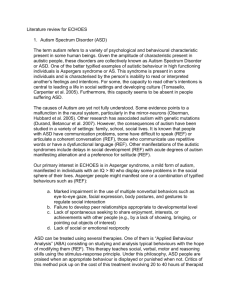Autism: From a "Speechie" Perspective
advertisement
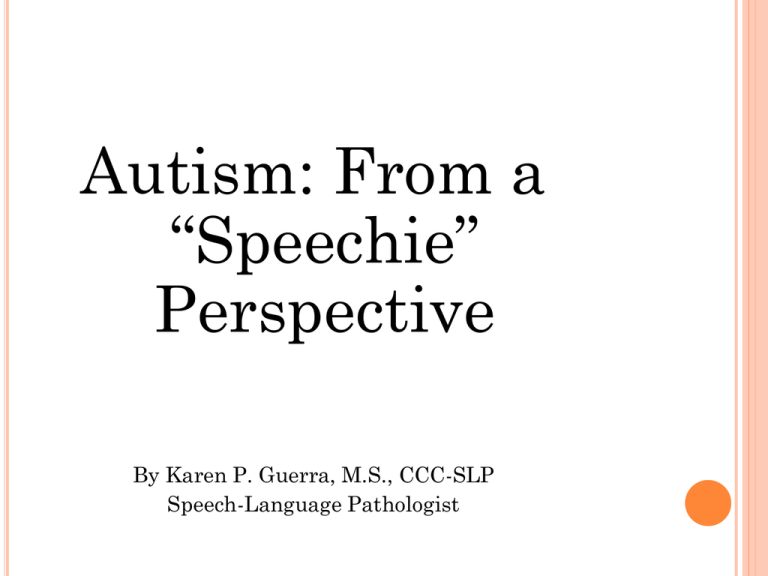
Autism: From a “Speechie” Perspective By Karen P. Guerra, M.S., CCC-SLP Speech-Language Pathologist ANXIOUS?? CONFUSED?? UNCOMFORTABLE?? HELP IS HERE!! WHAT IS AUTISM? Autism is defined by the Autism Society Of America (ASA) as: "Autism is a complex developmental disability that typically appears during the first three years of life and is the result of a neurological disorder that affects the normal functioning of the brain, impacting development in the areas of social interaction and communication skills. Both children and adults with autism typically show difficulties in verbal and non-verbal communication, social interactions, and leisure or play activities. MAIN UMBRELLA TERM IS “PDD” Autism is one of five disorders that falls under the umbrella of Pervasive Developmental Disorders (PDD), a category of neurological disorders characterized by “severe and pervasive impairment in several areas of development." SOME CHARACTERISTICS MAY INCLUDE: May exhibit self injurious behavior when upset i.e. biting selves or banging heads. An overall difficulty interacting with others. No fear of danger. Over or under sensitivity to pain. May avoid eye contact with you. May prefer to be by him/herself. Has difficulty expressing what they want or need - may then try to use gestures. May echo words or phrases. May have inappropriate attachments to objects. CONTINUED… May spin his/herself or objects. Prolonged repetitive play. May insist on things/routines always being the same. May exhibit inappropriate laughing (laughing when not appropriate to the situation). May display tantrums for no apparent reason. May avoid cuddling. ASSESSMENT- SPEECH THERAPY Each evaluation is different based on individual child Tests may be formal (standardized) or criterion referenced and observational Assessment determines current skill levels in the following areas: Language Comprehension (and processing) Expressive Language Pragmatics Articulation, Voice, and Fluency May see the need for further evaluation SPEECH THERAPY Therapy is individualized to the needs and levels of each child Therapy goals will address Language Comprehension Expressive Language and Increasing Use of skills (interaction) STRATEGIES TO IMPROVE COMMUNICATION Get Attention Use interests Use facial expression Simple Language Reduce number of words and complexity Repetition Emphasis on areas that need increasing Visual Cues Visual learners VISUAL STRATEGIES Signs and Sign Language Pictures and Symbols VISUAL STRATEGIES Schedules There are a variety of schedule options Use a hierarchy to determine for each child Small object Representational part Photos Symbols Written EXAMPLES OF PICTURES AND SYMBOLS EXAMPLES OF PICTURES AND SYMBOLS BEHAVIOR AS A MEANS OF COMMUNICATION IN ASD What does this mean? Push work away Throw plate on the floor Flap hands and jump Spin around and around Pull Mom to the cookie jar Stand by the door and look out Cover ears BEHAVIOR AS COMMUNICATION IN ASD Be aware of these communication attempts Look for the antecedent to the behavior Verbalize the words to accompany the behavior GESTURES Immature Gestures May see pulling, leading Reach/grab but not a good point gesture Child may go to the area near what he wants Conventional Gestures Interpret gesture with appropriate language ECHOLALIA Immediate or delayed May serve a variety of functions Turn taking Confirmation of a choice Association to similar situation Add language to help child relate to current event or alternative response WAYS TO INCREASE EXPRESSIVE COMMUNICATION Provide frequent models, repetition Shape vocalizations or approximations Expand on simple utterance Relate echolalic response to current situation Provide choices, verbal and visual INCREASING INTERACTIONS WITH CHILDREN WITH ASD Children with ASD have a more limited repertoire of communication functions than children with typical development These children had relative skill in regulating an adult’s behavior to achieve an environmental end They had higher rate of requesting and protesting than children with typical development (Wetherby & Prutting, 1984) INCREASING INTERACTIONS WITH CHILDREN WITH ASD Children with ASD exhibit less frequent use and later development of communication for social interactions Directing attention to self (show off) Acknowledging others Commenting Symbolic play (Wetherby, 1986; Wetherby & Prutting, 1984) *Joint Attention!! CONCLUDING THOUGHTS Language activities should encourage spontaneous communication Observe the entire child, consider the options Consult references for best practices Build language functions If the child is having fun, you will have fun Notes: Notes: REFERENCES Wetherby, A. (1986). Ontogeny of communicative functions in autism. Journal of Autism and Developmental Disorders, 16, 295-316. Wetherby, A., & Prutting, C. (1984). Profiles of communicative and cognitive-social abilities in autistic children. Journal of Speech and Hearing Research, 27, 364-377. www.asa.com (definitions and characteristics)



